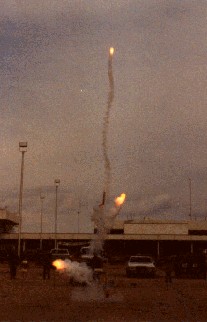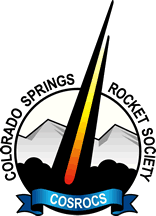Just what is a CATO?
and why would it happen to me? The word CATO indicates a CATastrOphic failure of a rocket engine.
CATOs are uncommon, however, when they do occur, they tend to happen mostly to the larger black-powder Rocket motors - such as C5s, D12s and E15s. The cause is usually the result of temperature cycling of the motors (such as leaving them in the trunk of a car and having them get very hot, then very cold many times). This causes small internal cracks in the compressed powder which, when ignited, burns at a different rate than it should. If it burns too fast, it will either blow out thru the ejection charge, or the engine casing will split. A blow thru often damages the metal blast deflector (a big dent, if the engine is shot down from the body tube). A CATO that splits the Engine casing typically destroys the lower portion of the Rocket.
 Photo by Jens Moller Photo by Jens Moller CATOs are also possible with the composite propellants found in Mid and High power motors, although the cause is not the same. Composite motors are generally lit at the top, which means that much more of the igniter is inside the motor at ignition. Especially with the smaller motors/nozzles, the igniter can stick and plug the nozzle, resulting in an over-pressurization of the casing. One or both of the closures may get blown off, or the casing can even rupture. In other cases, improper assembly of the delay may allow combustion gasses to leak by and light the ejection charge at liftoff. This also causes flame to shoot out of both ends of the motor to the detriment of the rocket's interior.
In any case, when a black powder charge CATOs, it typically burns out entirely in a second or 2. Composite propellant can burn much longer because it burns relatively slow when not confined and some of the larger motors obviously have more propellant to burn. These instances can cause fires if you are not prepared for them. The COSROCS launch team is prepared for them and has never had an instance where a fire has resulted at any of their launches - we are very preventative about safety issues.
So, what can you do to prevent a CATO? The simplest thing is to use use fresh motors and once you get them, protect them from temperature extremes. For example, In the Winter months here in Colorado, I keep my D12 motors in my shirt pocket, under my jacket, until I am ready to launch. Don't leave them outside when you are not using them and try to avoid situations where the engines might get subjected to temperature extremes. Use care when assembling composite reloads and make sure the igniter can easily slide back out at ignition.
CATOs rarely ever happen on 1/2A, A or B motors. This is mostly because there is less compressed powder to fracture internally.
As always, be careful with your Rocket motors and treat them with respect. Model Rocketry is a safe sport, and we want to keep it that way. If you have a CATO with an ESTES Black Powder motor in an ESTES kit, they may replace the kit - If you have this sort of failure, save the components to mail back to them. | 